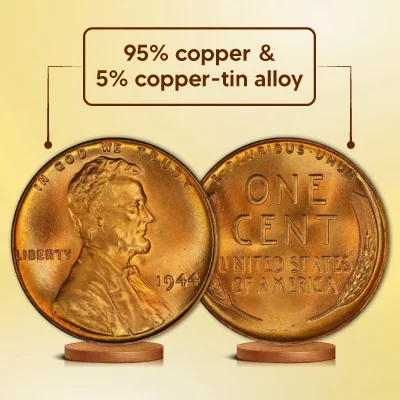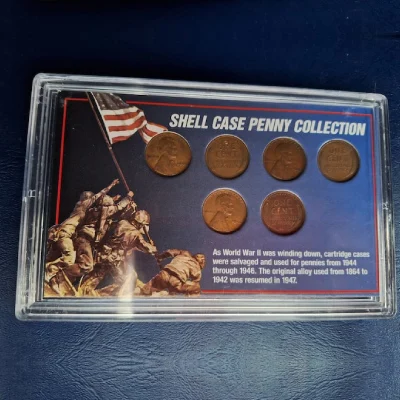
And so it’s obvious that the 1944 Penny value soared due to its historical importance and rarity in the world of numismatics.

Amidst all these recalls, it's evident why people often refer to the past as "Old is gold", especially when it comes to such rare coins. Imagine going through your grandfather’s old coin collection and seeing a penny that seems as old as time. Even when regular items stand the test of time and survive for several decades, they turn into artifacts!

However, they are now some of collectors’ most prized possessions. From its unique look to its historical significance, multiple factors have increased the 1944 penny value over time.
If you have one of these in your collection, you might be harboring a fortune! Let us dive a little deeper into the significance and value of the 1944 Wheat Penny.
The 1944 penny, also known as the 1944 Wheat Penny, is a coin carrying the face value of one cent. Produced by the Philadelphia, Denver, and San Fransisco Mints in 1944, these coins weigh 0.1907 ounces and have smooth edges. They contain 95% copper and 5% copper-tin alloy.

Most of the 1944 penny value comes from the depiction of President Abraham Lincoln on its obverse side. Along with the President facing right, the obverse side also carries the American motto of “IN GOD WE TRUST”, right above Mr. Linoln’s head. To the left of the President’s profile is the term “LIBERTY.”
You can see the coin’s minting date under the President’s chin or near his torso. Its obverse side also contains mintmarks, depending on the location where it was produced. While the Philadelphia pennies do not carry any mintmarks, the ones produced at Denver and San Fransisco carry the “D” and “S” mintmarks respectively.
The 1944 penny’s reverse shows the capitalized denomination. Under the denomination, it reads “UNITED STATES OF AMERICA.” The mints also struck the motto “E PLURIBUS UNUM” above the coin’s denomination.
Both the denomination and the “UNITED STATES OF AMERICA” inscription are surrounded by two wheat sheets. You guessed it, this is where the 1944 penny gets its name!
One of the biggest reasons why the 1944 penny value is high amongst coin connoisseurs today is the fact that these were the first US coins to depict a prominent historical figure.
Back in the day, George Washington was against this idea, calling it too monarchical.
Before Victor David Brenner came on board to design these pennies, a sculptor named Augustus Saint-Gaudens was to do the job. Unfortunately, Augustus passed away in 1907, so he could not submit the final coin design.
This is how the design job fell in Victor’s lap. In fact, a few of the Wheat Pennies are also called VDB (Victor David Brenner) pennies because of the designer’s initials on them. If you have one of these pennies, you have a valuable asset in your collection!

In 1944, the world witnessed the Second Great War, during which America was an active warrior. Owing to such circumstances, rumors about shell cases (an integral part of ammunition) being used for making the 1944 Wheat Pennies were common. Discussions about the same continue to this day.
A large section of people are of the opinion that this is an urban legend, waiving it off as a patriotic publicity stunt.
However, there is enough proof to suggest that the war increased the copper supply due to the recycling of the ammunition shell metal. The same shell metal could very well have been used in the production of these pennies.

If you stumble upon a 1944 Wheat Penny in your house, you might want to know its true value. If you are lucky, you might be sitting on some great fortune!
The best way to assess the 1944 penny value is to follow these three steps:
Let us have a quick look at each of these steps:
First of all, take a look at your coin’s mintmark. If you cannot find one, your 1944 Wheat Penny was produced by the Philadelphia Mint.
First of all, take a look at your coin’s mintmark. If you cannot find one, your 1944 Wheat Penny was produced by the Philadelphia Mint
In 1944, over 2.1 billion pennies were minted. Out of these, over half of them (~1.4 billion) were struck at the Philadelphia Mint.
On a rarity scale, these coins can be considered abundant. With the production of over 430 million coins, the 1944-D Wheat Penny can also be considered abundant on the rarity scale.
As compared to these two varieties, the San Fransisco (1944-S) pennies are considered more valuable thanks to their relatively higher exclusivity. Showing a slight premium, the San Fransisco mint produced over 282 million pennies in 1944.
Provided your coin is well-struck and has all details clearly visible (and keeping other factors constant), a 1944-S Wheat Penny will give you the maximum value.
Further, you can determine the 1944 penny value by assessing its grade. There are dedicated grading companies that give every penny a specific grade, making your assessments easier.
Here are the major grades that help you determine your 1944 Wheat Penny’s value:
As the name suggests, these coins retain their original luster and characteristics as they are never circulated. They show no signs of wear and are preserved with bright luster. Such mint state pennies are highly valuable and can get you a good price in the open market.
Once a penny is minted, it does not retain its original bright red-gold color for long. Over time, the penny’s color changes to a browner shade. This is known as the toning of a coin.
Please note that toning does not indicate wear and does not reduce a coin’s grade. Mint state (MS) coins can be toned without showing any signs of wear.
1944 pennies with an extremely fine grade show slight circulation wear. Most of these coins show wear signs on the high points of their designs. For example, you should check for wear signs on President Lincoln’s ear and the hair above it.
These are the 1944 pennies showing signs of moderate to heavy wear. Being affordable, they are often found in the collections of young and novice coin collectors.
The table below shows how the 1944 penny value changes with a change in the mintmarks and coin conditions (grades):
| Date | Mint Mark | Good | Fine | Extremely Fine | Uncirculated |
|---|---|---|---|---|---|
| 1944 | None (Philadelphia) | $0.02 | $0.02 | $0.04 | $1.56 |
| 1944 | D (Denver) | $0.02 | $0.02 | $0.04 | $1.22 |
| 1944 | S (San Francisco) | $0.03 | $0.03 | $0.05 | $1.86 |
After you have assessed your 1944 penny’s date, mintmark, and condition, you should look for special qualities. Most of these special qualities revolve around minting errors. In the world of coins, errors are viewed positively. A 1944 penny with an error makes it rare, thereby increasing its market value.
The Mint made various errors while producing these pennies. For example, punching the coin blank with high speed may lead to a slight misalignment if the blank is hit from an area that is close to previous punches. Such an incident leads to a clipped-planchet error.

Now that we are discussing special qualities, leaving out the 1944 Steel Wheat Pennies would be a travesty! Made from zinc-coated steel, these pennies (if uncirculated) carry the most valuable 1944 penny value, capable of fetching you as much as $1 million!
These steel pennies are the only regular-issue US coins a magnet can attract. Back in the day, this led to several issues. For example, the magnet (called a “slug”) used in vending machines to pick counterfeit coins would often pick genuine steel pennies, too.
While the original 1944 steel pennies also included copper, the US Government decided to release a special edition of these coins using zinc-coated steel.
This was clearly due to an increased demand for copper during WWII. Due to rusting issues, the minting of these steel coins was terminated almost as soon as it began.
The reason why a 1944 zinc-coated steel penny carries such high value is that the US Mint produced no more than twenty to forty of such pennies.

have a look at the key factors affecting the 1944 Penny value:Now that we know how to assess your penny to know its true value let us
The condition or grade of your coin has a direct influence on its value. For example, an uncirculated grade 1944 penny will be more valuable than an extremely fine grade. On the other hand, a penny with a rare error will demand a much higher price than the other coins.
The Economic basics of demand and supply tell us that a commodity that is high in demand is considered more valuable. If coin collectors start investing in a specific 1944 penny variant, its prices will increase in no time.
There are three kinds of 1944 pennies you can purchase in terms of mintmarks – Philadelphia coins, Denver coins, and San Fransisco coins. Of these, the San Fransisco coins are likely to boast a higher 1944 penny value because of the lowest mintage.
General economic market conditions also have a direct impact on 1944 Wheat Pennies. When an economy undergoes periods of uncertainty, the sale of precious metals skyrockets.
1944 is the year when the battle of Normandy shook the world with its infamous D-day. As the Second World War was at its peak, many coin collectors considered the coins minted in 1944 special. As a result, the inherent value of 1944 pennies increases.
After such a long discussion, you may ask, “So, how much is a 1994 penny worth today?” Before you get in touch with a trusted coin dealer to purchase these historically significant coins or sell one of yours, have a look at this table to know the current 1944 penny value:
| Lincoln Penny | DESIGNATION | MS63 | MS64 | MS65 | MS66 | MS67 | MS68 |
|---|---|---|---|---|---|---|---|
| 1944 | RD+ | $8 $9 | $12 $13 | $16 $20 | $30 $42 | $240 $650 | $13,000 |
| 1944 Steel | MS+ | $87,000 | $185,000 | ||||
| 1944-D | RD+ | $6 $8 | $12 $14 | $20 $22 | $37 $55 | $165 $525 | $9,000 |
| 1944-D Steel | MS | $90,000 | |||||
| 1944-D/S | BN+ | $450 $460 | $500 $565 | $650 $675 | $850 | ||
| 1944-D/S | RB+ | $450 $475 | $550 $625 | $1,000 | |||
| 1944-D/S | RD+ | $600 $625 | $675 $1,150 | $1,400 $1,750 | $2,500 $16,500 | $45,000 $57,500 | |
| 1944-S | RD+ | $10 $11 | $14 $15 | $18 $20 | $26 $32 | $135 $857 | |
| 1944-S Steel | MS+ | $10 $11 | $14 $15 | $18 $20 | $475,000 | $135 $857 |
The above chart shows the worth of several 1944 pennies according to grade and mintmark. With the addition of mintmarks and rare steel pennies, their value may skyrocket, reaching as high as $185,000! That’s pretty high.
1944 was a significant year in American history, making the 1944 Wheat Penny a special coin. If you are an avid coin collector, you should opt for rare and special edition 1944 pennies to add to your collection. If you found a 1944 penny in your house, you should get it graded and assessed right away. Who knows, fortune may be knocking at your door!